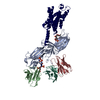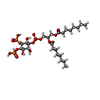+ データを開く
データを開く
- 基本情報
基本情報
| 登録情報 | データベース: PDB / ID: 8jru | |||||||||
|---|---|---|---|---|---|---|---|---|---|---|
| タイトル | Cryo-EM structure of the glucagon receptor bound to beta-arrestin 1 in ligand-free state | |||||||||
 要素 要素 |
| |||||||||
 キーワード キーワード | MEMBRANE PROTEIN / Complex structure / glucagon receptor / beta-arrestin 1 / ligand-free | |||||||||
| 機能・相同性 |  機能・相同性情報 機能・相同性情報protein C (activated) / renal water retention / Defective AVP does not bind AVPR2 and causes neurohypophyseal diabetes insipidus (NDI) / Vasopressin-like receptors / regulation of systemic arterial blood pressure by vasopressin / vasopressin receptor activity / positive regulation of establishment of endothelial barrier / negative regulation of coagulation / regulation of glycogen metabolic process / hemostasis ...protein C (activated) / renal water retention / Defective AVP does not bind AVPR2 and causes neurohypophyseal diabetes insipidus (NDI) / Vasopressin-like receptors / regulation of systemic arterial blood pressure by vasopressin / vasopressin receptor activity / positive regulation of establishment of endothelial barrier / negative regulation of coagulation / regulation of glycogen metabolic process / hemostasis / glucagon receptor activity / telencephalon development / positive regulation of systemic arterial blood pressure / negative regulation of blood coagulation / positive regulation of intracellular signal transduction / cellular response to glucagon stimulus / exocytosis / response to starvation / peptide hormone binding / endocytic vesicle / Gamma-carboxylation of protein precursors / Transport of gamma-carboxylated protein precursors from the endoplasmic reticulum to the Golgi apparatus / Common Pathway of Fibrin Clot Formation / Removal of aminoterminal propeptides from gamma-carboxylated proteins / positive regulation of vasoconstriction / cellular response to hormone stimulus / activation of adenylate cyclase activity / Intrinsic Pathway of Fibrin Clot Formation / cellular response to starvation / hormone-mediated signaling pathway / response to nutrient / guanyl-nucleotide exchange factor activity / viral budding from plasma membrane / generation of precursor metabolites and energy / response to cytokine / Cell surface interactions at the vascular wall / Post-translational protein phosphorylation / peptide binding / clathrin-coated endocytic vesicle membrane / adenylate cyclase-modulating G protein-coupled receptor signaling pathway / adenylate cyclase-activating G protein-coupled receptor signaling pathway / Glucagon signaling in metabolic regulation / regulation of blood pressure / Glucagon-type ligand receptors / negative regulation of inflammatory response / Vasopressin regulates renal water homeostasis via Aquaporins / Golgi lumen / Regulation of Insulin-like Growth Factor (IGF) transport and uptake by Insulin-like Growth Factor Binding Proteins (IGFBPs) / blood coagulation / Cargo recognition for clathrin-mediated endocytosis / glucose homeostasis / Clathrin-mediated endocytosis / G alpha (s) signalling events / G alpha (q) signalling events / clathrin-dependent endocytosis of virus by host cell / cell surface receptor signaling pathway / host cell surface receptor binding / endosome / G protein-coupled receptor signaling pathway / negative regulation of cell population proliferation / endoplasmic reticulum lumen / fusion of virus membrane with host plasma membrane / serine-type endopeptidase activity / fusion of virus membrane with host endosome membrane / viral envelope / calcium ion binding / positive regulation of cell population proliferation / positive regulation of gene expression / virion attachment to host cell / negative regulation of apoptotic process / host cell plasma membrane / virion membrane / perinuclear region of cytoplasm / Golgi apparatus / endoplasmic reticulum / proteolysis / extracellular space / extracellular region / identical protein binding / membrane / plasma membrane 類似検索 - 分子機能 | |||||||||
| 生物種 |   Influenza A virus (A型インフルエンザウイルス) Influenza A virus (A型インフルエンザウイルス) Homo sapiens (ヒト) Homo sapiens (ヒト)  Escherichia phage EcSzw-2 (ファージ) Escherichia phage EcSzw-2 (ファージ) | |||||||||
| 手法 | 電子顕微鏡法 / 単粒子再構成法 / クライオ電子顕微鏡法 / 解像度: 3.5 Å | |||||||||
 データ登録者 データ登録者 | Chen, K. / Zhang, C. / Lin, S. / Zhao, Q. / Wu, B. | |||||||||
| 資金援助 |  中国, 2件 中国, 2件
| |||||||||
 引用 引用 |  ジャーナル: Nature / 年: 2023 ジャーナル: Nature / 年: 2023タイトル: Tail engagement of arrestin at the glucagon receptor. 著者: Kun Chen / Chenhui Zhang / Shuling Lin / Xinyu Yan / Heng Cai / Cuiying Yi / Limin Ma / Xiaojing Chu / Yuchen Liu / Ya Zhu / Shuo Han / Qiang Zhao / Beili Wu /  要旨: Arrestins have pivotal roles in regulating G protein-coupled receptor (GPCR) signalling by desensitizing G protein activation and mediating receptor internalization. It has been proposed that the ...Arrestins have pivotal roles in regulating G protein-coupled receptor (GPCR) signalling by desensitizing G protein activation and mediating receptor internalization. It has been proposed that the arrestin binds to the receptor in two different conformations, 'tail' and 'core', which were suggested to govern distinct processes of receptor signalling and trafficking. However, little structural information is available for the tail engagement of the arrestins. Here we report two structures of the glucagon receptor (GCGR) bound to β-arrestin 1 (βarr1) in glucagon-bound and ligand-free states. These structures reveal a receptor tail-engaged binding mode of βarr1 with many unique features, to our knowledge, not previously observed. Helix VIII, instead of the receptor core, has a major role in accommodating βarr1 by forming extensive interactions with the central crest of βarr1. The tail-binding pose is further defined by a close proximity between the βarr1 C-edge and the receptor helical bundle, and stabilized by a phosphoinositide derivative that bridges βarr1 with helices I and VIII of GCGR. Lacking any contact with the arrestin, the receptor core is in an inactive state and loosely binds to glucagon. Further functional studies suggest that the tail conformation of GCGR-βarr governs βarr recruitment at the plasma membrane and endocytosis of GCGR, and provides a molecular basis for the receptor forming a super-complex simultaneously with G protein and βarr to promote sustained signalling within endosomes. These findings extend our knowledge about the arrestin-mediated modulation of GPCR functionalities. | |||||||||
| 履歴 |
|
- 構造の表示
構造の表示
| 構造ビューア | 分子:  Molmil Molmil Jmol/JSmol Jmol/JSmol |
|---|
- ダウンロードとリンク
ダウンロードとリンク
- ダウンロード
ダウンロード
| PDBx/mmCIF形式 |  8jru.cif.gz 8jru.cif.gz | 235.4 KB | 表示 |  PDBx/mmCIF形式 PDBx/mmCIF形式 |
|---|---|---|---|---|
| PDB形式 |  pdb8jru.ent.gz pdb8jru.ent.gz | 160.8 KB | 表示 |  PDB形式 PDB形式 |
| PDBx/mmJSON形式 |  8jru.json.gz 8jru.json.gz | ツリー表示 |  PDBx/mmJSON形式 PDBx/mmJSON形式 | |
| その他 |  その他のダウンロード その他のダウンロード |
-検証レポート
| 文書・要旨 |  8jru_validation.pdf.gz 8jru_validation.pdf.gz | 1.3 MB | 表示 |  wwPDB検証レポート wwPDB検証レポート |
|---|---|---|---|---|
| 文書・詳細版 |  8jru_full_validation.pdf.gz 8jru_full_validation.pdf.gz | 1.3 MB | 表示 | |
| XML形式データ |  8jru_validation.xml.gz 8jru_validation.xml.gz | 37.9 KB | 表示 | |
| CIF形式データ |  8jru_validation.cif.gz 8jru_validation.cif.gz | 54.6 KB | 表示 | |
| アーカイブディレクトリ |  https://data.pdbj.org/pub/pdb/validation_reports/jr/8jru https://data.pdbj.org/pub/pdb/validation_reports/jr/8jru ftp://data.pdbj.org/pub/pdb/validation_reports/jr/8jru ftp://data.pdbj.org/pub/pdb/validation_reports/jr/8jru | HTTPS FTP |
-関連構造データ
| 関連構造データ |  36606MC  8jrvC M: このデータのモデリングに利用したマップデータ C: 同じ文献を引用 ( |
|---|---|
| 類似構造データ | 類似検索 - 機能・相同性  F&H 検索 F&H 検索 |
- リンク
リンク
- 集合体
集合体
| 登録構造単位 | 
|
|---|---|
| 1 |
|
- 要素
要素
| #1: タンパク質 | 分子量: 54307.141 Da / 分子数: 1 / 由来タイプ: 組換発現 由来: (組換発現)  Influenza A virus (strain A/Victoria/3/1975 H3N2) (A型インフルエンザウイルス), (組換発現) Influenza A virus (strain A/Victoria/3/1975 H3N2) (A型インフルエンザウイルス), (組換発現)  Homo sapiens (ヒト) Homo sapiens (ヒト)遺伝子: HA, PROC, GCGR, AVPR2, ADHR, DIR, DIR3, V2R 発現宿主:  参照: UniProt: P03435, UniProt: P04070, UniProt: P47871, UniProt: P30518 | ||||||
|---|---|---|---|---|---|---|---|
| #2: 抗体 | 分子量: 69173.891 Da / 分子数: 3 / 由来タイプ: 組換発現 / 由来: (組換発現)  発現宿主:  #3: 抗体 | | 分子量: 13867.408 Da / 分子数: 1 / 由来タイプ: 組換発現 由来: (組換発現)  Escherichia phage EcSzw-2 (ファージ) Escherichia phage EcSzw-2 (ファージ)発現宿主:  #4: 化合物 | ChemComp-PIO / [( | 研究の焦点であるリガンドがあるか | Y | |
-実験情報
-実験
| 実験 | 手法: 電子顕微鏡法 |
|---|---|
| EM実験 | 試料の集合状態: PARTICLE / 3次元再構成法: 単粒子再構成法 |
- 試料調製
試料調製
| 構成要素 | 名称: The glucagon receptor bound to beta-arrestin 1 / タイプ: COMPLEX / Entity ID: #1-#3 / 由来: MULTIPLE SOURCES |
|---|---|
| 由来(天然) | 生物種:  Homo sapiens (ヒト) Homo sapiens (ヒト) |
| 由来(組換発現) | 生物種:  |
| 緩衝液 | pH: 7.5 |
| 試料 | 濃度: 6 mg/ml / 包埋: NO / シャドウイング: NO / 染色: NO / 凍結: YES |
| 急速凍結 | 凍結剤: ETHANE |
- 電子顕微鏡撮影
電子顕微鏡撮影
| 実験機器 |  モデル: Titan Krios / 画像提供: FEI Company |
|---|---|
| 顕微鏡 | モデル: FEI TITAN KRIOS |
| 電子銃 | 電子線源:  FIELD EMISSION GUN / 加速電圧: 300 kV / 照射モード: SPOT SCAN FIELD EMISSION GUN / 加速電圧: 300 kV / 照射モード: SPOT SCAN |
| 電子レンズ | モード: BRIGHT FIELD / 最大 デフォーカス(公称値): 1500 nm / 最小 デフォーカス(公称値): 800 nm |
| 撮影 | 電子線照射量: 70 e/Å2 フィルム・検出器のモデル: GATAN K3 BIOQUANTUM (6k x 4k) |
- 解析
解析
| CTF補正 | タイプ: NONE | ||||||||||||||||||||||||
|---|---|---|---|---|---|---|---|---|---|---|---|---|---|---|---|---|---|---|---|---|---|---|---|---|---|
| 3次元再構成 | 解像度: 3.5 Å / 解像度の算出法: FSC 0.143 CUT-OFF / 粒子像の数: 250907 / 対称性のタイプ: POINT | ||||||||||||||||||||||||
| 拘束条件 |
|
 ムービー
ムービー コントローラー
コントローラー




 PDBj
PDBj




























